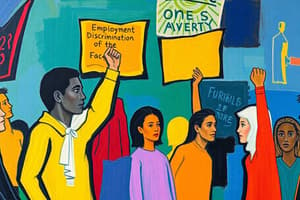Podcast
Questions and Answers
Which classes of employees are protected against discrimination under federal law?
Which classes of employees are protected against discrimination under federal law?
- National origin
- Race
- Age
- All of the above (correct)
What is the role of the Equal Employment Opportunity Commission?
What is the role of the Equal Employment Opportunity Commission?
To monitor employers and ensure compliance with federal employment discrimination laws.
What is disparate-treatment discrimination?
What is disparate-treatment discrimination?
Employment discrimination resulting from intentional actions by an employer against members of protected classes.
What is disparate-impact discrimination?
What is disparate-impact discrimination?
What are employers obligated to do regarding employees' religious practices?
What are employers obligated to do regarding employees' religious practices?
Define constructive discharge.
Define constructive discharge.
What does quid pro quo mean in a workplace context?
What does quid pro quo mean in a workplace context?
What is a hostile environment?
What is a hostile environment?
What is the difference in employer liability between quid pro quo harassment and hostile environment harassment?
What is the difference in employer liability between quid pro quo harassment and hostile environment harassment?
Study Notes
Protected Classes
- Employees are protected against discrimination based on national origin, race, color, religion, gender, age, military status, or disability under federal law.
Equal Employment Opportunity Commission (EEOC)
- EEOC monitors compliance with federal employment discrimination laws.
- Claimants must file with the EEOC before pursuing discrimination lawsuits.
- The EEOC investigates priority claims and seeks to mediate resolutions.
- If no settlement occurs, the EEOC may file claims on behalf of the aggrieved employee.
- Claimants can sue their employer if the EEOC chooses not to pursue a claim.
Disparate-treatment Discrimination
- Involves intentional discrimination against employees in protected classes.
- Difficult to prove in court; specific procedures exist to address this.
- If proven, the burden shifts to the employer to provide a lawful justification for their actions.
Disparate-impact Discrimination
- Refers to unintentional discrimination resulting from employer practices or tests that appear neutral but have a discriminatory effect.
- Plaintiffs must demonstrate that the employer's actions lead to a discriminatory outcome.
- The burden then shifts to the employer to justify the practices or procedures.
Employer Obligations for Religious Practices and Disabilities
- Employers must accommodate employees' sincerely held religious beliefs, such as requests for specific days off.
- Reasonable accommodations are required for employees with disabilities to perform essential job functions.
- Examples of reasonable accommodations include modified job assignments, flexible hours, or accessible workspaces.
- Employers are not required to accommodate if it would cause undue hardship.
Constructive Discharge
- Defined as an employee’s resignation due to intolerable working conditions.
- Example: A manager schedules an employee for undesirable shifts to pressure them into resigning instead of firing.
Quid Pro Quo
- Refers to a situation where employment benefits are conditioned on sexual favors or other exchanges.
- Examples include demands for sexual favors in exchange for promotions or salary increases.
Hostile Environment
- Occurs when discriminatory behavior creates a severe or pervasive work environment, impacting employee conditions.
- Harassment can be characterized by singular severe incidents or repeated lesser acts.
Employer Liability: Quid Pro Quo vs. Hostile Environment
- For liability in quid pro quo harassment, a significant employment action (e.g., termination) must occur.
- Liability in hostile environment cases may arise from severe or pervasive discriminatory actions affecting the victim's employment conditions.
Studying That Suits You
Use AI to generate personalized quizzes and flashcards to suit your learning preferences.
Description
Explore the critical concepts of employment discrimination and the role of the Equal Employment Opportunity Commission in this Chapter 18 flashcard quiz. Understand the protected classes under federal law and the responsibilities of employers. Test your knowledge about essential labor laws and guidelines.




